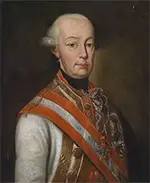Leopold II: Holy Roman Emperor
Leopold II was Holy Roman Emperor for a time in the late 18th Century. 
He was born on May 5, 1747 in Vienna. His father was the reigning Holy Roman Emperor, Francis I, and his mother was Holy Roman Empress Maria Theresa. When Leopold was born, his parents were fighting the War of the Austrian Succession, a challenge to their right to rule. A final treaty in 1748 ended the war. Leopold was his parents' third son and so was earmarked for a career in the clergy. However, his older brother, Charles, died in 1761, when Leopold was 14. Francis and Maria Theresa then decided that Leopold was to be the next Duke of Tuscany, a title then held by his father. Four years later, Francis died and Leopold took over Tuscany. This occurred 13 days after Leopold had married Infanta Maria Luisa of Spain. Both Leopold and his wife were not from Italy, and the people of Tuscany did not warm to their rulers. Leopold ruled Tuscany for 25 years, gradually increasing the prosperity and image of his duchy by way of economic and social reforms. Like his brother Joseph, who succeeded their father as Holy Roman Emperor, Leopold believed in the ideas of the Enlightenment, a movement that emphasized reason and human rights such as basic freedoms and the pursuit of happiness. Leopold spearheaded the creation of a political constitution for Tuscany and also, in 1786, outlawed the death penalty. In the area of public health, he championed the use of inoculation to fight smallpox, which had killed many of his extended family. When Maria Theresa died, on Nov. 29, 1780, Joseph ruled the empire in his own right. He carried on in that vein for another decade, dying on Feb. 20, 1790. Leopold replaced him on the imperial throne. The new emperor turned his back on his reformist tendencies and set about exercising his imperial authority. He reversed some of Joseph's policies, including one that freed a large number of serfs. Many European countries at the time were in the midst of political upheaval. One of the most contentious was France, which by the time that Leopold ascended the peak of imperial reign was convulsing through the French Revolution. One of Leopold's sisters was Marie Antoinette, the Queen of France. Both Joseph and Leopold expressed a wish to support their sister and her husband, King Louis XVI. Leopold also enjoyed the support of other European monarchs in opposing the ideals of representation put forward by the leaders of the French Revolution. In August 1791, Leopold agreed with Prussian King Frederick William II to the Declaration of Pillnitz, a promise to help restore Louis XVI to his throne. (He had, by this time, been stripped of his absolute authority and was desperately trying to keep his throne by agreeing to a constitutional form of government.) France wasn't sitting idly during this time. Foreign Minister Charles François Dumouriez encouraged a rebellion in the Austrian Netherlands. The plan was for French troops to invade Austria and then join up with rebellious troops in the Low Countries and defeat the Austrian army. Dumouriez's plan called for a French victory in 15 days. Tensions between Austria and France continued to deteriorate, and the two countries went to war in April 1792. Leopold was not around to see it. He had died on March 1, 1792, in Vienna. Leopold and his wife, Maria Luisa, had had 16 children, 13 of whom survived into adulthood: Maria Theresa (1767), Francis (1768), Ferdinand (1769), Maria Anna (1770), Charles (1771), Alexander Leopold (1772), Joseph (1776), Maria Clementina (1777), Anton (1779), John (1782), Rainer (1783), Louis (1784), Rudolph (1788). |
|
Social Studies for Kids
copyright 2002–2024
David White




